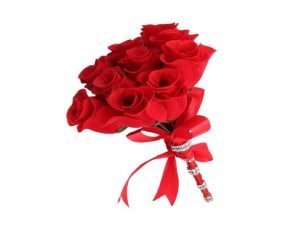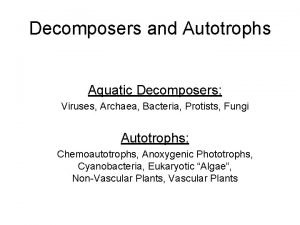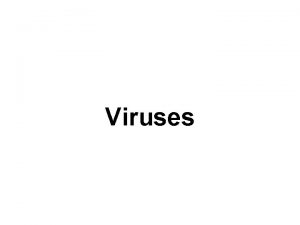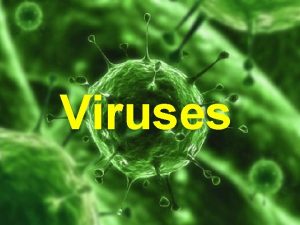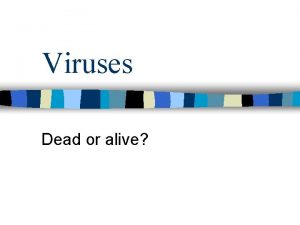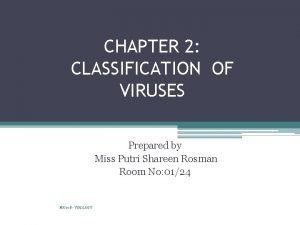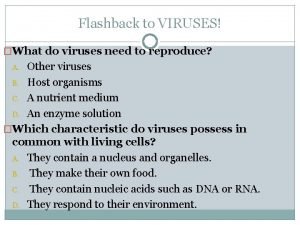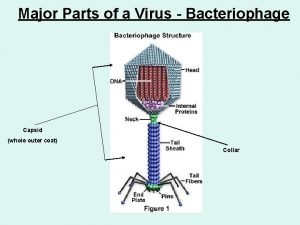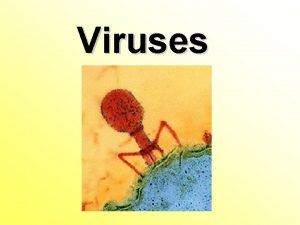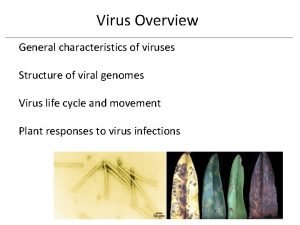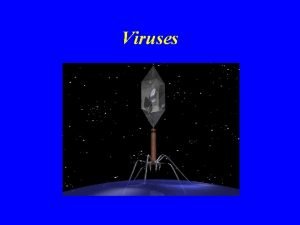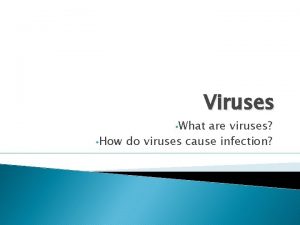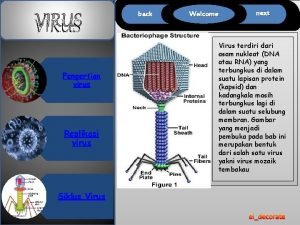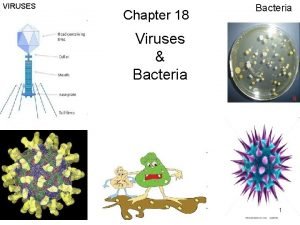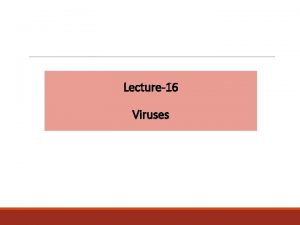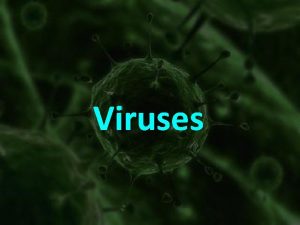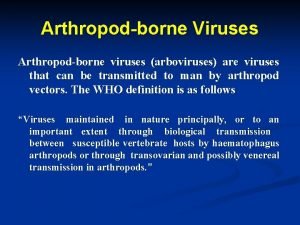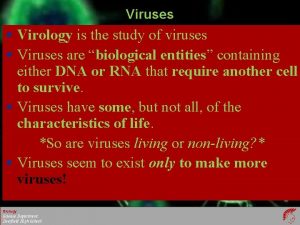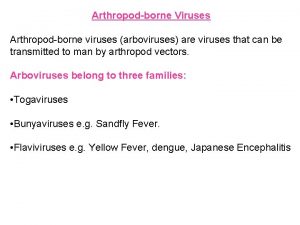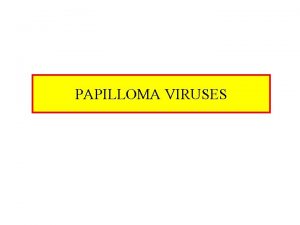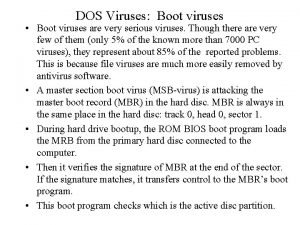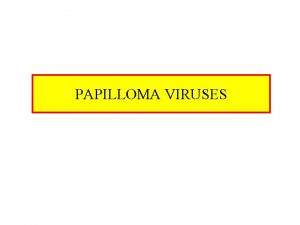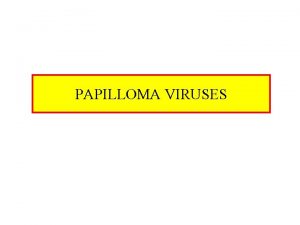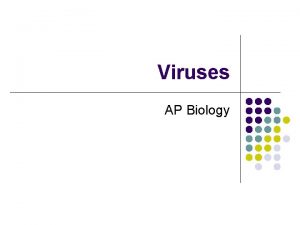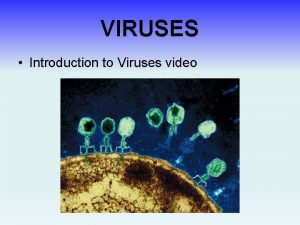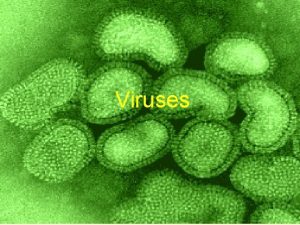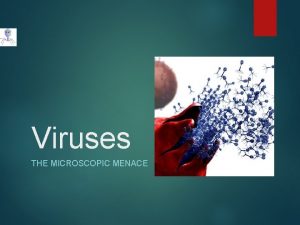VIRUS Virus Viruses cause many diseases in humans














































- Slides: 46

VIRUS

Virus Viruses cause many diseases in humans, animals and plants They are unique group of infectious agent. They are not cellular pathogen or parasite of bacteria, animals and plants. A complete virus particle or a virion consists of one or more molecules of DNA or RNA in a coat protein. Virus can exist in two phases. 1. Extracellular 2. Intracellular

In extracelluar phase, virus may not possess enzyme. If it is contains, it may be a few enzymes, virus cannot reproduce independently of living cells. In an intracellular phase, the viral nucleic acid replicates. Then it induces first all metabolisms to synthesize the various virus components. All the components are assembles to produce a complete virion or a virus particle. Then they release out of living microorganisms.

General characteristics of viruses Viruses contain a single type of nucleic acid, either DNA or RNA, never both. They contain a protein coat. They multiply inside living cells using the synthesizing machinary of cell. They cause the synthesis of specialized structures that can transfer the viral nucleic acid to other cells. They are easily transmitted from one organisms to another, and they are not affected by antibiotics. They are reproduce solely through their nucleic acid and are unable to grow or undergo inary fission.

Classification of Virus 1. Depending upon their primary characteristics Depending upon the chemical nature of nucleic acid eg: RNA or DNA, single or double stranded, single or segmented genome, (+) or (-) strands, molecular weight. Depending upon the structure of virus: Virus may be classified into different types, depending upon the capsid structure. a. Helical viruses: it resemble long rods that may be rigid or flexible. The voral nucleic acid found within a hollow, cylindrical capsid, which has a helical structure. Eg: Rabies virus, Tobacco mosaic virus.


b. Polyhedral ( icosahedral virus): The capsids of most polyhedral viruses have a shape of an icosahedron, a regular polyhedron with 20 triangular faces and 12 corners. The capsomers of each face form an equilateral triangle, eg: Adenovirus, Poliovirus. c. Enveloped viruses: They are roughly spherical but highly pleomorphic ( variable in shape) in nature. When helical or polyhedral viruses are enclosed by envelopes they are called enveloped helical (eg: Influenza virus) and enveloped polyhedral viruses (eg: Herpes simplex virus) d. Complex viruses: Some viruses, particularly bacterial viruses have very complicated structures. They are called complex virus.


Depending upon the size of the virus. Virus are much smaller than bacteria. As they are too small to be seen under the light microscope, they are called as ultramicroscopic

Depending upon the secondary characteristic of virus 1. Host range: Host specific a. Bacterial virus: These are those which are derived from the host bacteria, ( eg: Bacteriophage) b. Plant virus: They are derived from the host plant cell (eg: Tobacco mosaic virus) c. Animal virus: They are derived from the animals, human beings. 2. Specific surface structures, eg: angenic properties. 3. Mode of transmission eg: feces

STRUCTURE OF VIRUS A virus is acellular, i. e. it is NOT a cell as it has no nucleus, cytoplasm or organelles. Viruses have a simple structure consisting of a core of DNA or RNA, but not both. The DNA/RNA is not contained in a nuclear membrane. The nucleic acid is surrounded by a protein coat or capsid, In some viruses, the capsid is covered by an envelope of a lipid bilayer.

Nucleic acid : Virus contains a single kind of nucleic acid, either DNA or RNA, which is the genetic material. The percentage of nucleic acid in relation to protein is about 1% for the influenza viruses and about 50% for certain bacteriophages the nucleic acid of virus can be single stranded or double stranded. Capsid and envelope : The nucleic acid of a viruses is surrounded by a protein coat called the capsid. The structure of the capsid is ultimately determined by the viral nucleic acid. Each capsid is composed of protein subunits called capsomers. In some viruses, the capsid is covered by an envelope, which usually consists of some combination of lipids, proteins and carbohydrates.

Some animal viruses are released from the host cell and coats the virus with a layer of the host cells plasma membrane, that layer becomes the viral envelope Depending on the virus, envelopes may or may not be covered by spikes, which are carbohydrate protein complexes that project from the surface of the envelope. Some viruses attach to host cells by means of spikes. This is one of the characteristics used for identification of viruses. Viruses whose capsids are not covered by an envelope are known as naked viruses or non enveloped viruses.


CULTIVATION OF VIRUSES

Virus Cultivation Systems Laboratory animals Embryonated eggs system. Tissue culture system.

Laboratory animals Oldest method Animals used for the cultivation of virus are human volunteers (usually for yellow fever virus), monkeys, mice, infant mice, rabbits, guinea pigs and ferrets. Use of these animals is do not permitted due to the rules and regulations of animal ethical committee. Animal inoculation is use for the identifying and isolation from the clinical specimen Animals are inoculated with specimens and growth of virus may be observed by the sign of death, disease or visible lesions. Sometimes immunity in the experimental animal may interfere with the growth of virus in the animal Animal inoculation is also used for the study of pathogenesis, immune response and epidemiology.

Embryonated eggs The embryonated egg offers several sites for the cultivation of viruses. A hole is drilled in the shell of the embryonated egg. Viral suspension is injected into the respective membrane or respective cavity of egg which is most appropriate for the growth of virus. Viral growth in embryonated egg is indicated by cell damage, death of embryo, or formation of typical pock marks/ lesion on the egg membrane. This method is widely used in for viral preparation and growth and also for some viral vaccines.


Advantage of embryonated eggs 1. The eggs are much simpler to handle than animals. 2. Eggs are very economical and easily available 3. They do not need feeding and caging. 4. They do not have immune mechanisms like animals to counteract virus infection. 5. They are clean and bacteriologically sterile 6. Chick embryo offers several sites for cultivation of virus.

Disadvantage of embryonated eggs 1. Some virus do not show growth on primary inoculation intothe eggs 2. Slight amount of bacterial contamination in the inoculaums may kill the embryo 3. Eggs may be contaminated with mycoplasma and latent fowl viruses which may interfere with the growth of other viruses.

Tissue culture system For Cultivation Of Viruses Animal and plant viruses are cultivated in cell cultures. A cell culture is prepared by encouraging cell growth outside the animal or plant source. The cells are kept alive in a suspension of growth factors within a Petri dish. A thin layer of cells, or monolayer, is then inoculated with viruses, and replication takes place.

(Fertilized eggs and living animals can also be used to cultivate viruses. ) For research study, viruses can be cultivated in large volumes by inoculations to tissue culture systems. After a time, the cells are degenerated, and viruses are harvested.

there are mainly 3 types of tissue culture 1. Organ culture 2. Explants culture 3. Cell culture q Organ culture are useful for the isolation of some viruses which appear to be highly specialized parasites of certain organs, eg: tracheal ring organ culture is used for the isolation of corona virus

q Explants culture Minced tissue may be grown as explants embedded in plasma clots. This is not useful in virology But in past, the adenoid tissue explants cultures were used for adenovirus. q Cell culture This is very popular and useful technique routinely used for cultivation of viruses Tissue are dissociated into the component cells by the action of proteolytic enzyme such as trypsin and mechanical shaking. The cells are washed, counted and suspended in a growth medium and distributed in petri plates, test tubes or bottles The cells adhere to the glass surface and grow out to form a monolayer sheet

Depending upon their origin and characteristics, cell culture are classified into three types, 1. Primary cell culture These are normal cells freshly taken from the body and cultured. They are capable of only limited growth in a culture and cannot be maintained in serial culture. They are useful for isolation and cultivation of virus for vaccine production. Eg: Rhesus monkeys kidney cell culture, human embryonic kidney cell culture, human amnion cell, chick embryo fibroblast culture etc. .

2. Diploid cell strains Diploid cells are derived from primary cell cultures and established from a particular type of tissue, such as lung and kidney, which is embryonic in origin. The primary cell culture transferred to the nutritive medium of the cell culture and the process is called as sub-culturing. This cell culture obtained by sub-culturing of primary cell culture is called secondary cell. Sub-culturing can be performed for 50 generations after which primary cells die out. They posses the normal diploid karyotype. They are useful for the isolation of fastidious pathogen and also for the production of viral vaccine. Eg: cell culture derived from the human embryo is generally used for the production of rabies vaccine. By sub-culturing, cells up to 100 generation can be made. They are used for the culturing those virus require a human host.

3. Continuous cell line They are single type of cell mainly derived from cancer cells. These also can be grown in successive generations by transferring them from one test tube to another test tube with out change in their character of the cells. They have potential for unlimited growth and multiplication

REPLICATION OF VIRUS

















 Lytic cycle animation
Lytic cycle animation Youtube . com / watch v = roxnvcaezjs
Youtube . com / watch v = roxnvcaezjs Section 19-3 diseases caused by bacteria and viruses
Section 19-3 diseases caused by bacteria and viruses Lytta virus
Lytta virus How many pairs of chromosomes
How many pairs of chromosomes How many chromosomes do humans have
How many chromosomes do humans have Human ribs
Human ribs Karyotype
Karyotype Absolute threshold psychology definition
Absolute threshold psychology definition Number of chromosomes in meiosis
Number of chromosomes in meiosis Highest speed a human can run
Highest speed a human can run How many molars do adults have
How many molars do adults have Kinesis and taxis
Kinesis and taxis Proximate causes of behavior
Proximate causes of behavior Ter death certificate
Ter death certificate Proximate cause and ultimate cause
Proximate cause and ultimate cause Hepatotropic viruses
Hepatotropic viruses Why are viruses considered nonliving
Why are viruses considered nonliving Cultivation of viruses
Cultivation of viruses General properties of viruses
General properties of viruses Virinae
Virinae Best viruses
Best viruses Chapter 20 viruses and prokaryotes
Chapter 20 viruses and prokaryotes Lesson 1: viruses
Lesson 1: viruses Aquatic decomposers
Aquatic decomposers Viruses
Viruses How active viruses multiply
How active viruses multiply Hershey and chase experiment
Hershey and chase experiment How do viruses differ from living things
How do viruses differ from living things Hepatotropic viruses
Hepatotropic viruses Chapter 21 viruses and bacteria
Chapter 21 viruses and bacteria Basic properties of viruses
Basic properties of viruses Why are viruses considered nonliving?
Why are viruses considered nonliving? Are viruses dead or alive
Are viruses dead or alive Best viruses
Best viruses Virus taxonomy
Virus taxonomy Are viruses alive yes or no
Are viruses alive yes or no General characters of viruses
General characters of viruses Lysogenic viruses do not
Lysogenic viruses do not What is the smallest infectious agent
What is the smallest infectious agent Parts of a virus
Parts of a virus Importance of viruses
Importance of viruses Hepatotropic viruses
Hepatotropic viruses Nonliving particle that replicates inside a living cell
Nonliving particle that replicates inside a living cell General characteristics of viruses
General characteristics of viruses Tcid
Tcid General properties of viruses
General properties of viruses



